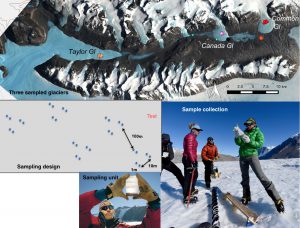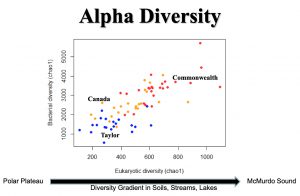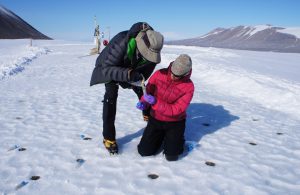We arrived at the Lake Hoare camp 8 days ago and the weather so far has been amazing! By amazing, I mean no further delays to get to our experiments on the top of the Canada Glacier. Otherwise, it’s been rather cold (temperatures consistently below freezing) and windy (up to 30 knots) and this makes the work difficult. No matter how many parkas we put on, to stay warm we have to jump around, windmill arms, and eat high energy snacks. The good news is that it has not snowed (too much) and thus cryconite holes can be easily spotted.
The project: From the previous post you already know that we study microbial communities in cryoconite holes, what cryoconite holes are, and how they form. This post provides a few details on why and how we study microbial communities in them.

Photo credit – Dorota Porazinska
Each cryoconite hole (and there are thousands of them on every glacier) is like its own independent mini ecosystem supporting its own microbial community. Each community includes fully functioning foodweb starting with photosynthetic microbes (i.e., cyanobacteria and algae) that produce food in the same way plants do, moving onto heterotrophic microbes that decompose and cycle nutrients, onto microscopic animals (i.e., rotifers and tardigrades) that can eat bacteria or prey on each other. In other words, it is like a “forest” with “trees” and “lions” but on a microscopic scale. We use these mini-ecosystems as models to understand how and why communities (including those of real forests) assemble and function because cryoconite communities need only a few years develop as opposed to thousands of years for forests.

Experiments: In the first year of our project (2016-17), we wanted to know if communities in cryoconite holes can be explained by factors that are associated with their surrounding environments. For instance, we hypothesized that diversity of microbial communities in natural cryoconite holes on different glaciers within the Taylor Valley will be paralleled by diversity gradients present in soils, streams, and lakes that surround these glaciers. Our first “natural experiment” involved selecting three glaciers along the Taylor Valley, sampling their natural cryoconite holes (with an ice corer), and sequencing their DNA to identify all the organisms living in them. Our data generally supported our hypothesis.

Some hypotheses, however, are hard to be answered with natural experiments and instead need to be tested by experimental manipulations. For instance, to test so called priority effects (where organisms that arrive first matter in how communities develop), we needed to establish our own cryoconite holes by varying identity of the arriving seeding material. For this experiment, we used communities associated with black vs. orange algal mats that form in nearby streams. Some holes were initiated with black mats and after they established, we added to them orange mats. Other holes were initiated with orange mats, and after they established, we added to them black mats. By tracing their progress through time, we will be able to determine if priority effects matter. The major objective of our last year’s (2017-18) work was to set up ~350 experimental holes.

Photo credit – Pacifica Sommers
This year, we will sample our holes at three time points (early Nov, mid Dec, and end of Jan) through the season to test whether, and if so, how, and why communities become the way they are. One of the main tasks in the early season was to find out if we can relocate and recover sediments from holes that we set up in the previous season. To increase our chances, we were assisted by high-precision GPS and drones experts (T. Nylen and S. Niebuhr from UNAVCO). I am excited to report that not only have we relocated all holes, but also succeeded with the first sampling point.
 0
0
